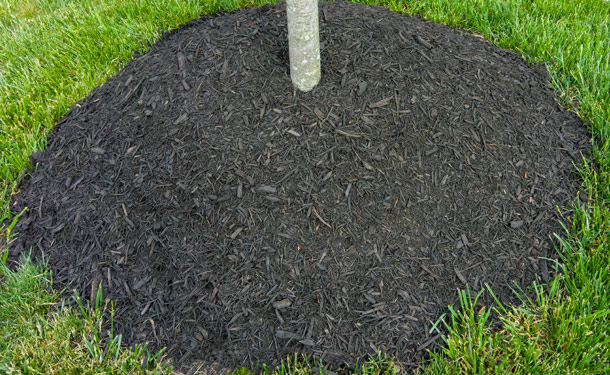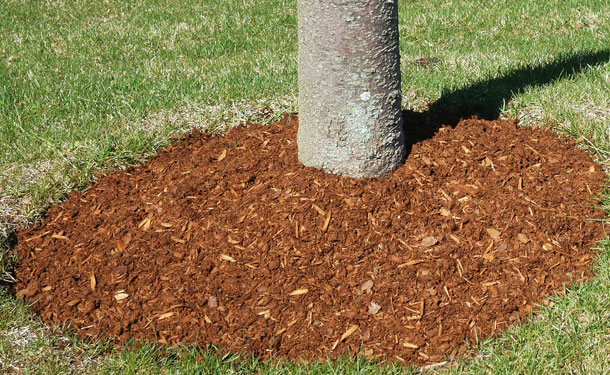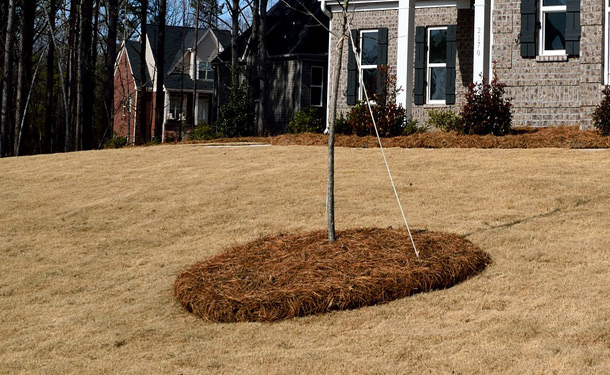Volcano mulching resembles a little volcano around the base of a tree trunk made from mulch. It may look cool, but it’s a death sentence for the tree.
Mulching is an essential part of tree care. However, volcano mulching is a practice which is a tree killer and is highly discouraged.

Read on as the team at thetreecareguide.com defines the importance of mulching, what it means for the health of a tree, the dangers of volcano mulching, and answers some commonly asked questions.
Mulch Volcanoes Are Tree Killers
A mulch volcano occurs when a thick layer of mulch is laid around a tree and piled up against the base of the trunk, covering the bark and root flare, resembling a volcano.
For one reason or another, this way of mulching seems to be fairly common, even prevalent in some regions. Landscapers, lawn services, home/business owners that are doing this may be under the assumption that mulch cannot harm trees. Sadly, they are mistaken.
This practice causes the bark at the base of the tree to be permanently shaded and in constant contact with moisture. The ramifications of volcano mulching for a tree are devastating and may result in the following:
- Cankers
- Splitting
- Disease
- Decay
- Insect infestation
- Root rot
- The death of the tree
- The unexpected falling of the tree
The tree in the image below may seem to be properly mulched but it is in fact volcano mulched. The level of mulch around the trunk is above the root flare and in contact with the bark.

Tree Bark – The dead tree cells that cover and defend a tree’s trunk, branches, and limbs compose what we know as bark. For bark to optimally serve its purpose (keeping insects and disease from making the tree a host) it needs air and light to remain hardened.
Over Mulching – Too much mulch can end up matted over time. Just as detrimental as volcano mulching, matted mulch acts as a barrier and stops water and air from reaching the roots. You can quickly solve this by fluffing it up with a rake and removing any excess, 2 to 4 inches thick is ideal.
For more info on growing healthier trees, read these 3 mulching tips.
Root Flare – Definition and Vulnerability
The root flare or root crown is the point at the base of a tree trunk where the trunk expands and transitions into the root system. Trees that sprout and grow naturally have the flare at ground level.
Maintaining this level is essential to the tree’s health for two particular reasons:
1 – From the root flare down, bark transitions to the outer layers of the roots, specialized in resisting constant exposure to soil moisture.
2 – Above the flare, is bark. Exposing this bark to constant moisture inhibits the transportation of oxygen and nutrients by the phloem, effectively girdling the tree.
When planting saplings, transplanting older trees, or mulching around any tree, the root flare must be kept at ground level, free from obstruction or coverage.
Pictured below, a sapling has been over mulched, covering the root flare.

Importance of Mulching
A 2 to 4-inch thick layer of organic mulch spread out on the root zone without making contact with the trunk (like a donut with the tree trunk in the center) is essential to your tree’s health for the following reasons:
Water Retention – Mulch helps retain water absorbed by the soil keeping the roots moist and preventing the hardening of the ground, especially during times of drought.
Soil Insulation – During times of extreme temperature fluctuations, mulch helps to regulate soil temperature, protecting the root system from both hot and cold temperatures.
Weed Prevention – Mulch prevents weeds from establishing themselves in the root zone of a tree.
People Also Ask
Q: Can Mulch Kill a Tree?
A: Yes. When improperly applied, mulch can lead to a series of vulnerabilities, the decline of the tree’s health, and eventual death.
Q: What is the Purpose of Mulch Around Trees?
A: Mulch insulates the root zone from extreme temperatures and helps retain moisture for optimal root growth conditions.
Q: Why Should I Keep Mulch Away from Tree Trunks?
A: Continued exposure to moisture weakens the bark, leaving it vulnerable to insect infestation and disease.
Q: How Deep Should the Mulch Be?
A: Spread organic mulch in the root zone in a 2 to 4-inch layer. Thicker than this is considered over mulching and may result in matting.
Q: Can You Put Fertilizer on Top of Mulch?
A: Yes. Applying a granular fertilizer over mulch is fine. It will slowly make its way to the soil and roots.
Q: What is the Best Mulch to Use?
A: Organic. Mulch is meant to decompose slowly and as it does, nutrients are infused into the soil. Mulches containing cypress and cedar are highly sought after, as are those which include pine needles or straw. Be aware that each type of mulch has both advantages and disadvantages.
Q: Is Compost Good for Mulch?
A: Not exactly. Compost comes packed with nutrients that you want to get to the roots; it is better when mixed with the soil.
Watch the following video to see how to correct a volcano mulched tree.
Proper Mulching for Healthy Trees
By avoiding volcano mulching, you are promoting the health of that tree and the safety of everything around it. Likewise, the proper mulching of a tree’s root zone helps the tree avoid the stressors of extreme temperatures and drought.
Volcano mulching invites a series of potential health problems for a tree, including severe implications around the area of the root flare. Knowing the importance and method of proper mulching is a fundamental part of keeping trees healthy.
Allowing trees to continue improperly mulched can quickly lead to disease or infestation, subsequently leading to health problems, their death, and potential falling.
Sources:
https://extension.illinois.edu/gardenerscorner/issue_07/spring_05_11.cfm
http://richmondtreestewards.org/education/threats-to-trees/volcano-mulching/
https://www.maine.gov/dacf/php/pesticides/documents2/master%20gardeners/mulch_volcano.pdf